What Are Biennials For?
Exhibition views of the 35th Bienal de São Paulo – choreographies of the impossible, 2023.
© Levi Fanan / Fundação Bienal de São PauloThe São Paulo Art Biennial, which dates back to 1951, is the second oldest and most significant of the twice-yearly art fairs after the Venice Biennale, which began in 1893 and has served as the model ever since. As convergences of contemporary art, national narratives, and dizzying wealth, biennials are indexes of international prestige. And as they have multiplied and matured (or regressed), they have also developed an accumulating set of norms and protocols. In 2022, I had a stingy three hours to wander the fifty-ninth Venice iteration, and—that being the sum total of my prior experience with biennials—I felt pitifully unprepared to grasp São Paulo with anything even remotely close to the comprehensive, aerial perspective of an art girlieTM.
Take this as factual, not hyperbolic: as my plane descended over the modular metropolis, there was no end to its reach. The city stretched on and on and on, introducing a feeling of overwhelm that shaped my impression of the biennial itself: it was too much to absorb. During the week I spent at the fair, I often worried about the wrong kind of legibility—the frustrating desire to understand everything I saw and heard, which would only prove, fittingly, impossible.
The biennial is a form committed to maximalism—so much so that its proliferation in recent decades has led to the invention of the term “biennialization” to describe the phenomenon. Today over three hundred take place across the globe. These large-scale exhibitions are typically viewed as venues for showcasing contemporary art outside of the traditional museum and marketplace ecosystems. Student protests in 1968, coupled with the larger anti-bourgeois and anti-consumer-culture flavors of the ’60s and ’70s, saw art-buying removed from many biennials, and distinguished them from other art fairs, like Frieze, where the primacy of sales is no secret. But the face of change can mask its opposite; the groundwork for selling is often laid at biennials. (“See in Venice, buy at Basel” and the “Venice Effect” are two phrases as annoying as they are telling). Since the birth of the biennial, materially speaking, more has stayed the same than has changed.
Yet for its thirty-fifth iteration, São Paulo named an intervention for changes tectonic, not just textural. The biennial this past September unsettled the expected hierarchical and cohesive approach to curation that typifies most art fairs—a system under which offerings are selected by a chief curator or a pre-constituted collective. São Paulo’s 2023 edition, by contrast, evinced a spirit of horizontal improvisation. The stewards of this biennial—independent curator Diane Lima, visual artist Grada Kilomba, anthropologist Hélio Menezes, and former museum director Manuel Borja-Villel—adopted a collective approach to assemble choreographies of the impossible.

Curatorial collective of the 35th Bienal de São Paulo, from left to right: Manuel Borja-Villel, Diane Lima, Grada Kilomba and Hélio Menezes.
© Levi Fanan / Fundação Bienal de São PauloOne of their curatorial texts described this counter-dance as beginning with “practice, which has as its principle the attempt to break hierarchies, ethical and normative procedures that stage vertical structures of power, value and violence of institutional devices—which, we all know, the world no longer sustains.” They named an attempt to break with a continuously oppressive world order—against fascisms, old and new, towards freedoms, unrealized and dreamed.
The vision of choreographies of the impossible unfurled as a dance through and across the spheres and scales of the territorial, oceanic, corporeal, and spiritual, guided by the curators’ stated Black feminist orientation. This was particularly evident in the richness of the performance and public programming of the first week. The curation centered the artistic and expressive practices of people of African and Indigenous descent—of two groups, that is, who together constitute the majority but structurally dispossessed population of Brazil—and of the Global South, cast across diasporas and ancestral homes, ruptured and reconfigured through shared histories of colonial invasion and imperialist domination. The effect was exultant, full of dizzying uncertainty, and of course not without frictions and hiccups.
But what could truly be broken and remade through spiral interventions—and adrift in this vast labyrinth of an art fair? What would I be able to translate, to tell of it?
*
Bracketing the effervescent excitement, traveling to São Paulo for the first time felt oddly unsettling. A ten-hour flight with only a one-hour time difference? Four mornings in a row, I set out on my walk to the pavilion. It would take twenty-nine minutes along Rua Tomás Carvalhal from the apartment where I was staying, according to the map. Over my many comings and goings, I never seemed able to find the pavilion intentionally, rather stumbling correctly by accident. Low and long, the substantial size of the building was not particularly helpful in locating it.
Since its fourth iteration in 1957, the São Paulo Art Biennial has taken place in the verdant expanse of Ibirapuera Park, and is housed inside the Ciccillo Matarazzo Pavilion designed by Hélio Uchôa and the famed Oscar Niemeyer. The pavilion is one of the latter’s many architectural icons of Brazilian modernism. A mammoth three-story and thirty-thousand-square-meter rectangular structure, the building carries a weighty history and symbolic heft as a rhapsody to modernity. Contained here, the biennial is a palimpsest of both Brazil’s history and of its own layered past. Not only did choreographies of the impossible prioritize artists historically marginalized by the white, Western art world, it also adapted the pavilion’s interior in ways that seemed to challenge that art world’s symbolic sanctity.
Niemeyer’s Brazilian modernist design already offered some compatibility with this biennial: the pavilion’s three open levels are connected by a serpentine ramp that weaves through each floor, comprising a large spiral. But the curators called on a Brazilian architectural firm, Vão, to help make the space even more conducive to their project. The architects’ primary alteration was to cover the sides of the ramps, rendering the space’s expansive sight lines fragmented and veiled. A shift from openness to enclosure might seem to conflict with this biennial’s liberatory vision (and this actually troubled me very much the first few days—while I loved the resulting spatial cocoons afforded by these changes, I vaguely worried I was enjoying a cushy cage). But Euro-American modernity was constituted in part by domineering visual regimes—by imperial powers imposing their authority on conquered peoples who were forced into the documented, regulated spheres of the West’s own allegedly superior systems of knowledge. Transforming the panopticon-like feel of the pavilion into spaces that escaped full visual capture suggested a different epistemology, an alternative choreography of encounters.
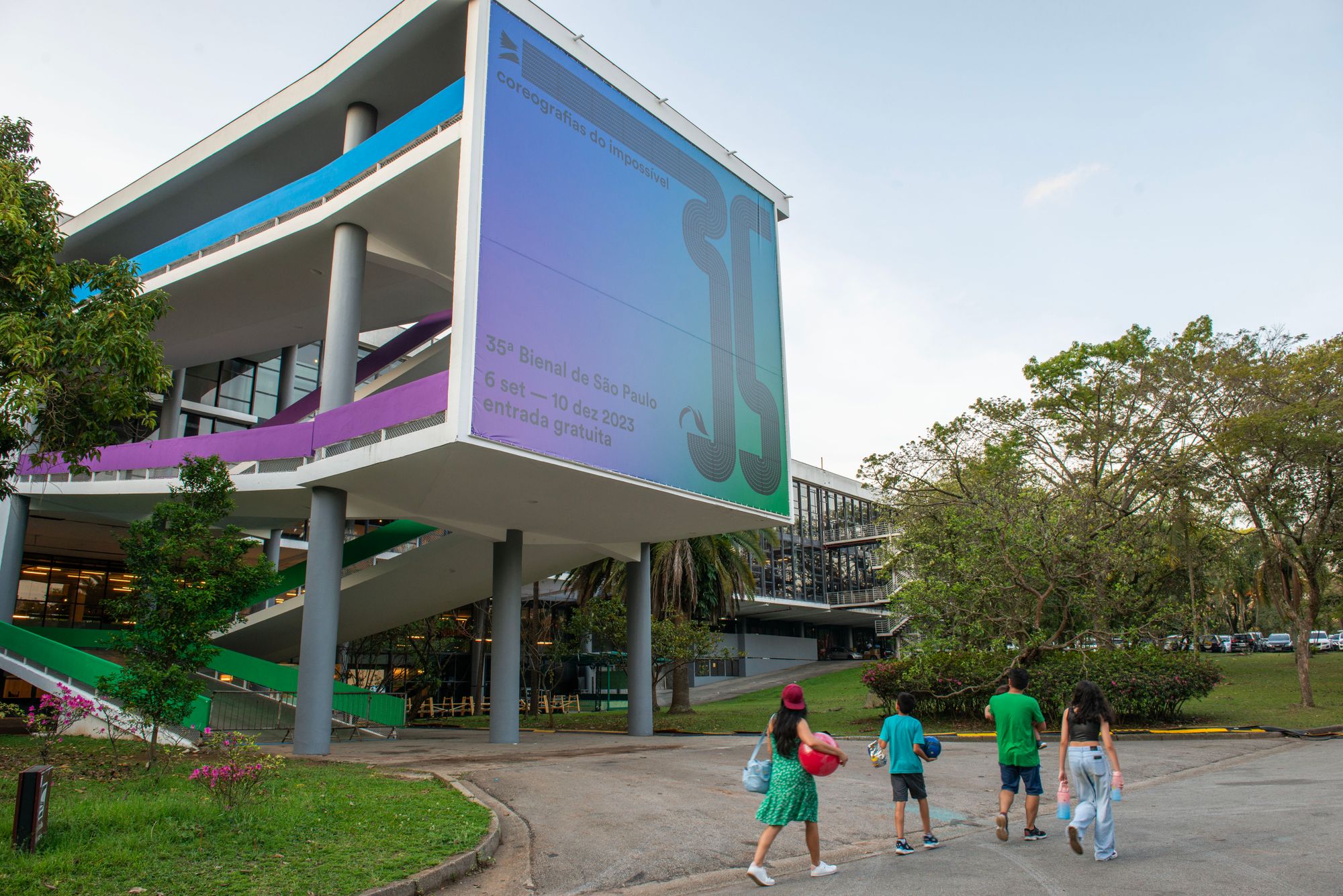
I didn’t have much of a plan beyond “wander and see,” but being a moving image devotee, I sought out the video, filmic, and para-filmic elements first—and before all else, a space dedicated to Sarah Maldoror, the poetic and political Pan-Africanist liberatory French-Guadeloupean filmmaker. A roomy alcove displayed treasures such as Maldoror’s feature on the Angolan liberation struggle, Sambizanga (1972), on loop; a TV monitor playing her short Regards de mémoire (2003); and production stills showing her focused and resolute. Other ephemera included traces of unrealized work, budget breakdowns, a cardboard-brown ID card with her discarded government name, and pages and pages of notes, often scribbled in red or green ink with the penmanship of someone on the go and perceptibly educated in the French system. On the first day I ran into the filmmaker’s daughter, Annouchka de Andrade, whose tireless dedication to her mother’s legacy is… everything? Of anyone I have never met and can never hope to, Sarah Maldoror is the closest to my core. For her, I have an attachment that spills far beyond my writing and research and film programming, into the realm of a sort of quotidian low-frequency propaganda aimed at anyone and everyone, from my students in class to one bad date. Here, this affection translated into tidal waves of joy, seeing an entire room dedicated—lyrically, militantly—to her inheritance.

Exhibition views of the 35th Bienal de São Paulo – choreographies of the impossible © Levi Fanan / Fundação Bienal de São Paulo
Courtesy of the 35th Bienal de São PauloAfter this encounter with the familiar, I kept getting lost. Pouring over the map of the pavilion I tried purposelessly to direct myself to this or that video and failed. I could not translate abstract cartography into embodied movement. And that failure was a welcome invitation by the curators, it seemed, to give in fully to their wayward choreographies. What pleasure in a maze if the path is evident?
Such spatial mistranslations, ultimately welcome, clarified the centrality of translation to the totality of this experience. Like several but not all of the public programs, the opening panel with Lima, Kilomba, Menezes, and Borja-Villel included headsets with live translation as well as sign language. Menezes offered a brief citation from James Baldwin’s “Letter from a Region in My Mind,” in which he names the place where Black life meets the impossible. Baldwin’s incendiary pen carved a Black truth about the ignorance of white America and the irreconcilable violence of racial hierarchies—the “impossible” referring both to the improbable continuation of Black life and to the necessity of a world where mere survival would not be so precarious.
Lima addressed the wayward temporality of their approach to the biennial, with nonlinear time as a mercurial tool for research. Troubled temporality was key to the conceptual orientation of their curation, specially nurtured by the writings of Brazilian scholar Leda Maria Martins, who flanked the panel of curators as one of two guiding lights, alongside Gladys Tzul Tzul, a Maya K'iche' activist and artist who spoke beautifully and in rigorous detail about an array of indigenous community processes. Tzul Tzul reflected on decentralized governance and autonomous lifeways which persist in defiance of colonial states. And while Martins’ notion of “spiraling time” infused choreographies of the impossible, so did her writings on the performance, religious practices, dancing ceremonies, and musical rituals of Afro-Brazilian Congado. Spiraling time evokes continual returns, reinventions and crossroads: encounters which may tend towards the cosmic but are very much corporeal, enacted in dance and gesture. Drawing from this wellspring, the curators foregrounded peoples whose histories, systems of knowledge, and cultural practices challenge the linearity and chronological arc of Western colonial modernity.

Exhibition views of the 35th Bienal de São Paulo – choreographies of the impossible, 2023.
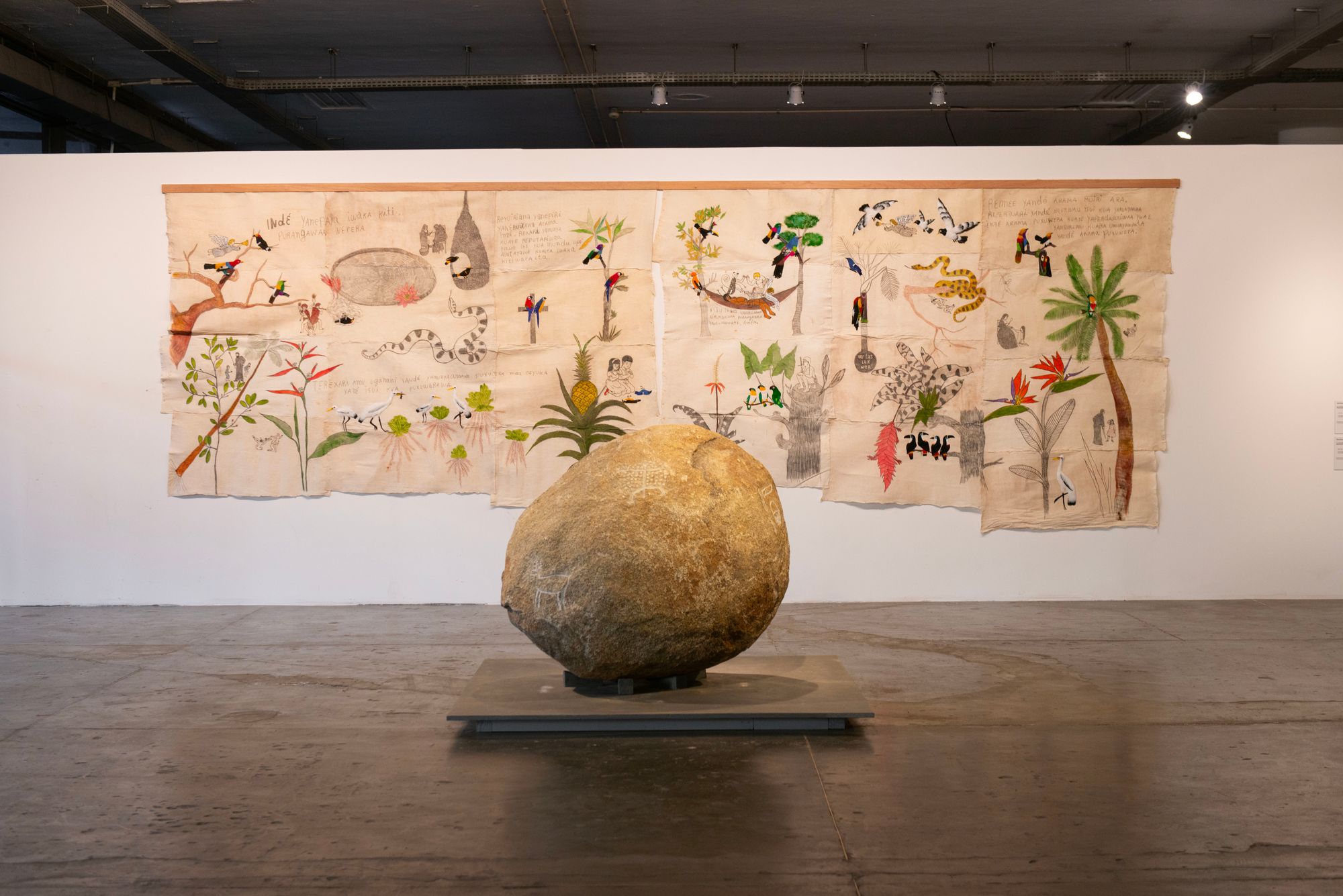
Exhibition views of the 35th Bienal de São Paulo – choreographies of the impossible, 2023.
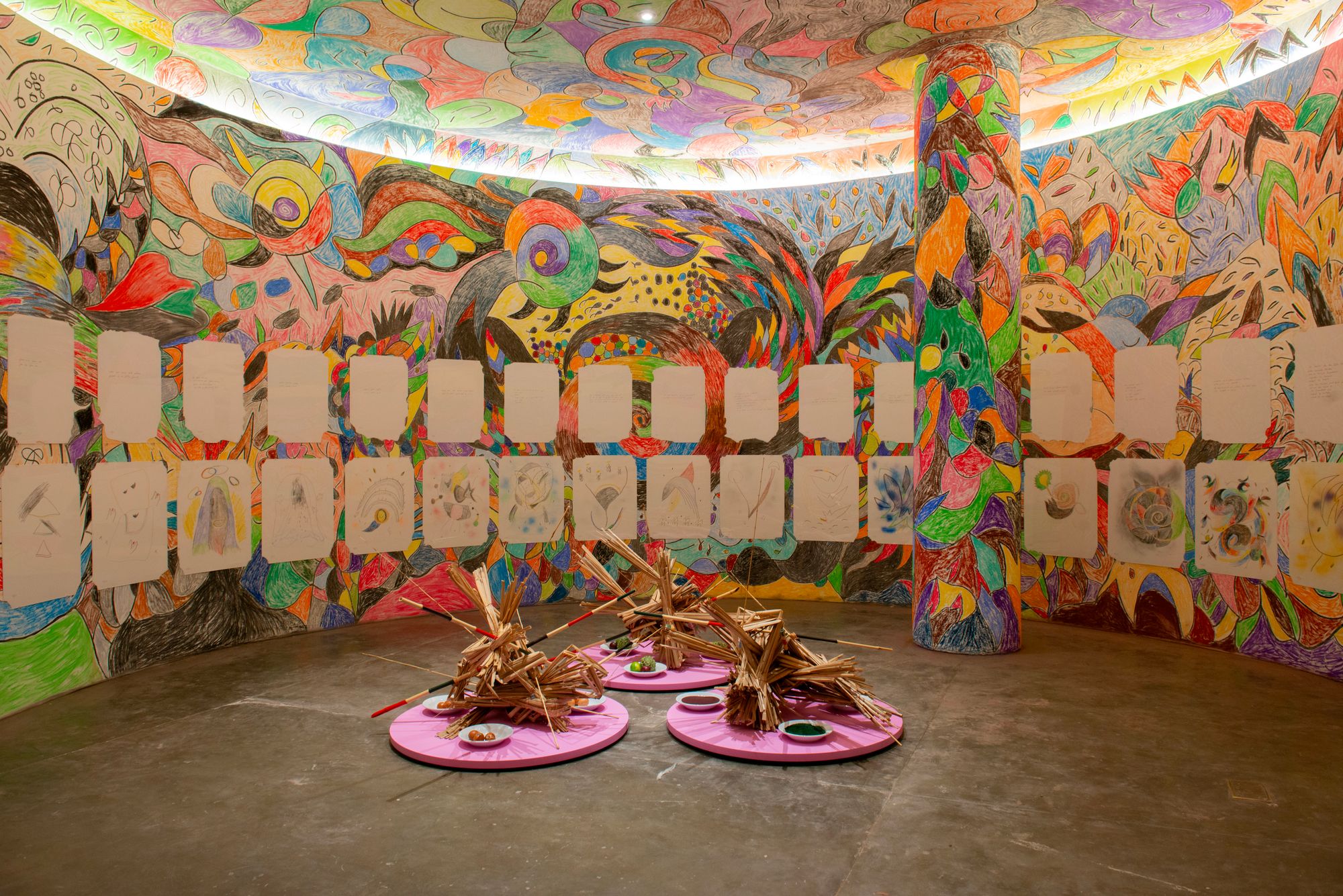
Exhibition views of the 35th Bienal de São Paulo – choreographies of the impossible, 2023.

Exhibition views of the 35th Bienal de São Paulo – choreographies of the impossible, 2023.
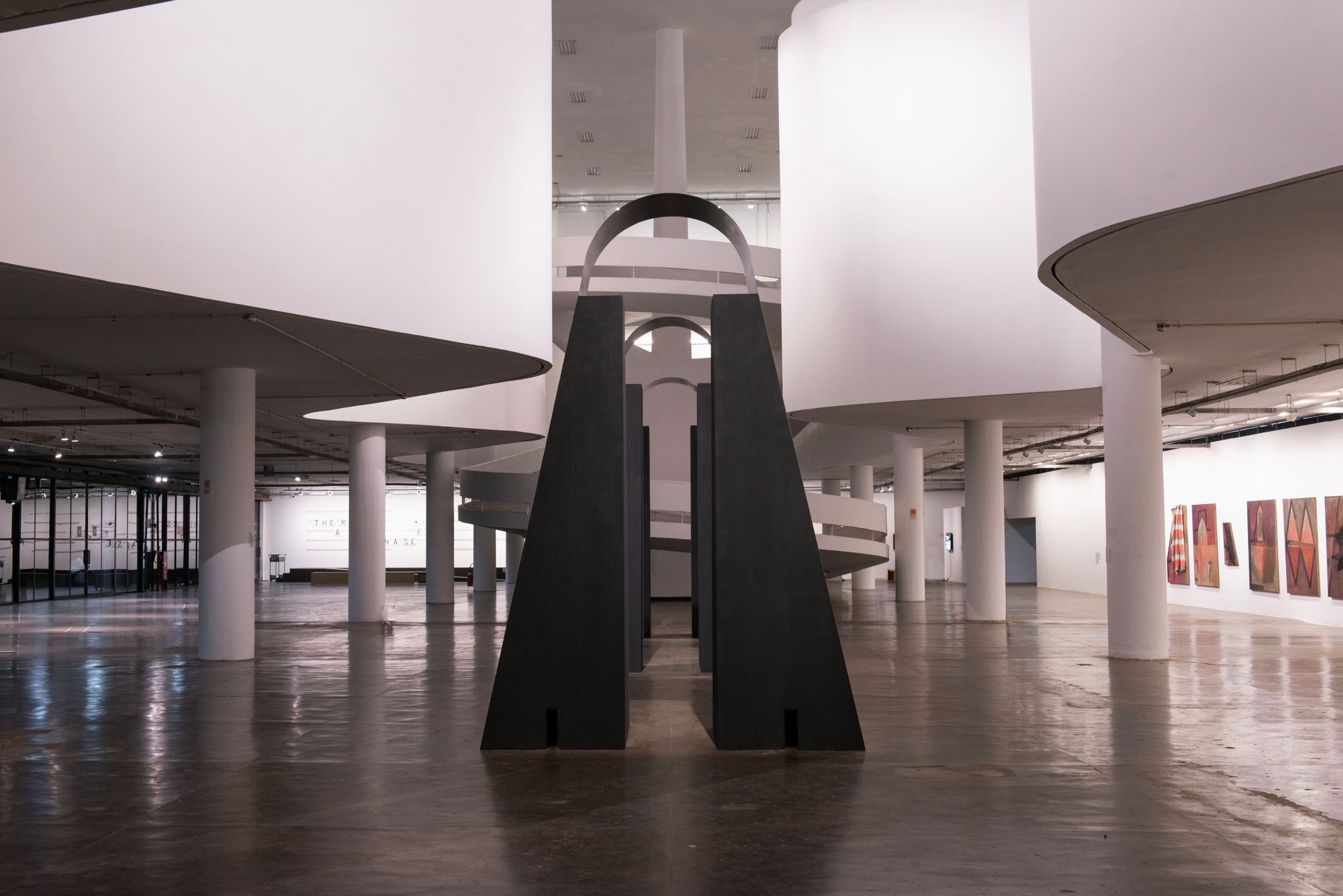
Exhibition views of the 35th Bienal de São Paulo – choreographies of the impossible, 2023.
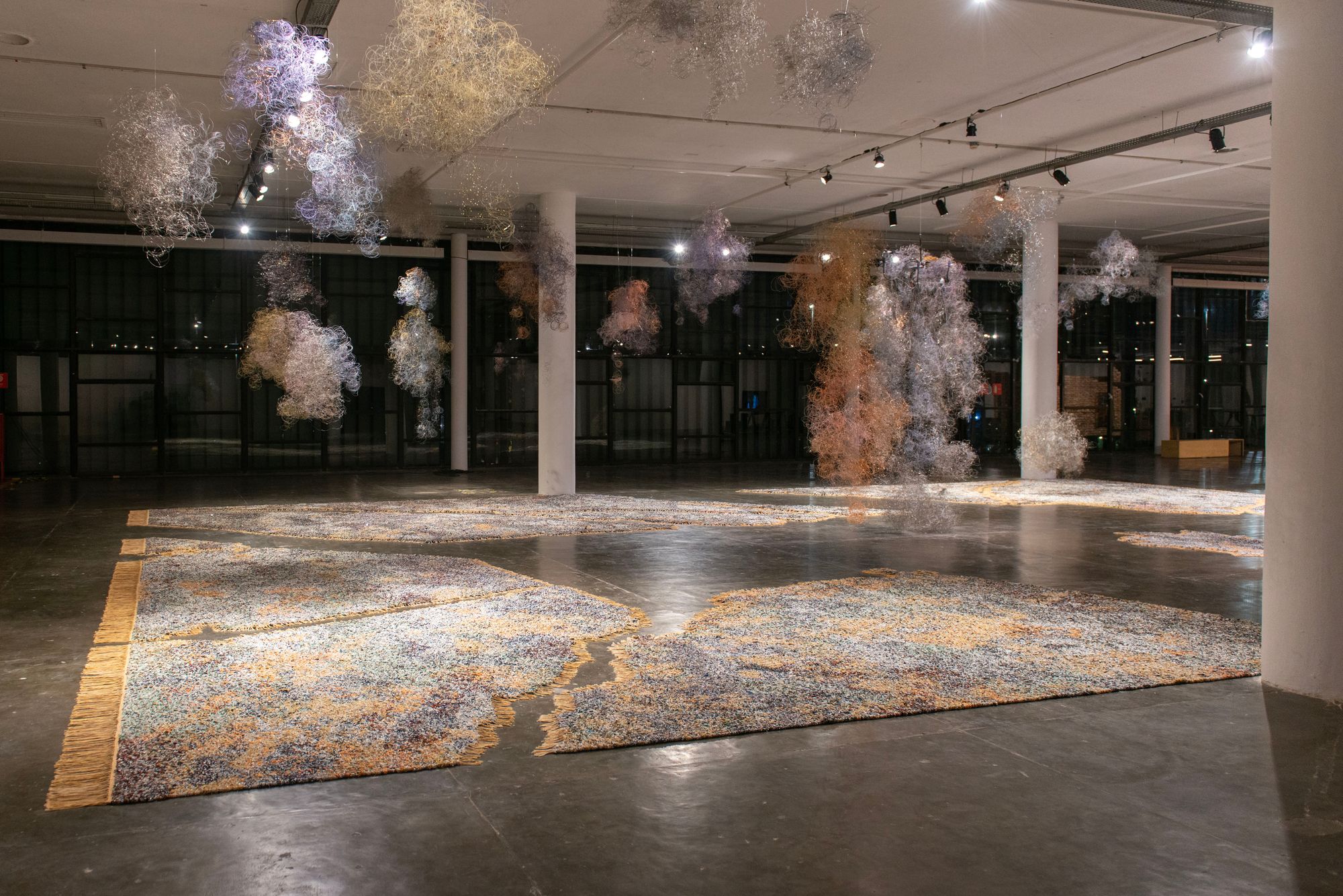
Exhibition views of the 35th Bienal de São Paulo – choreographies of the impossible, 2023.
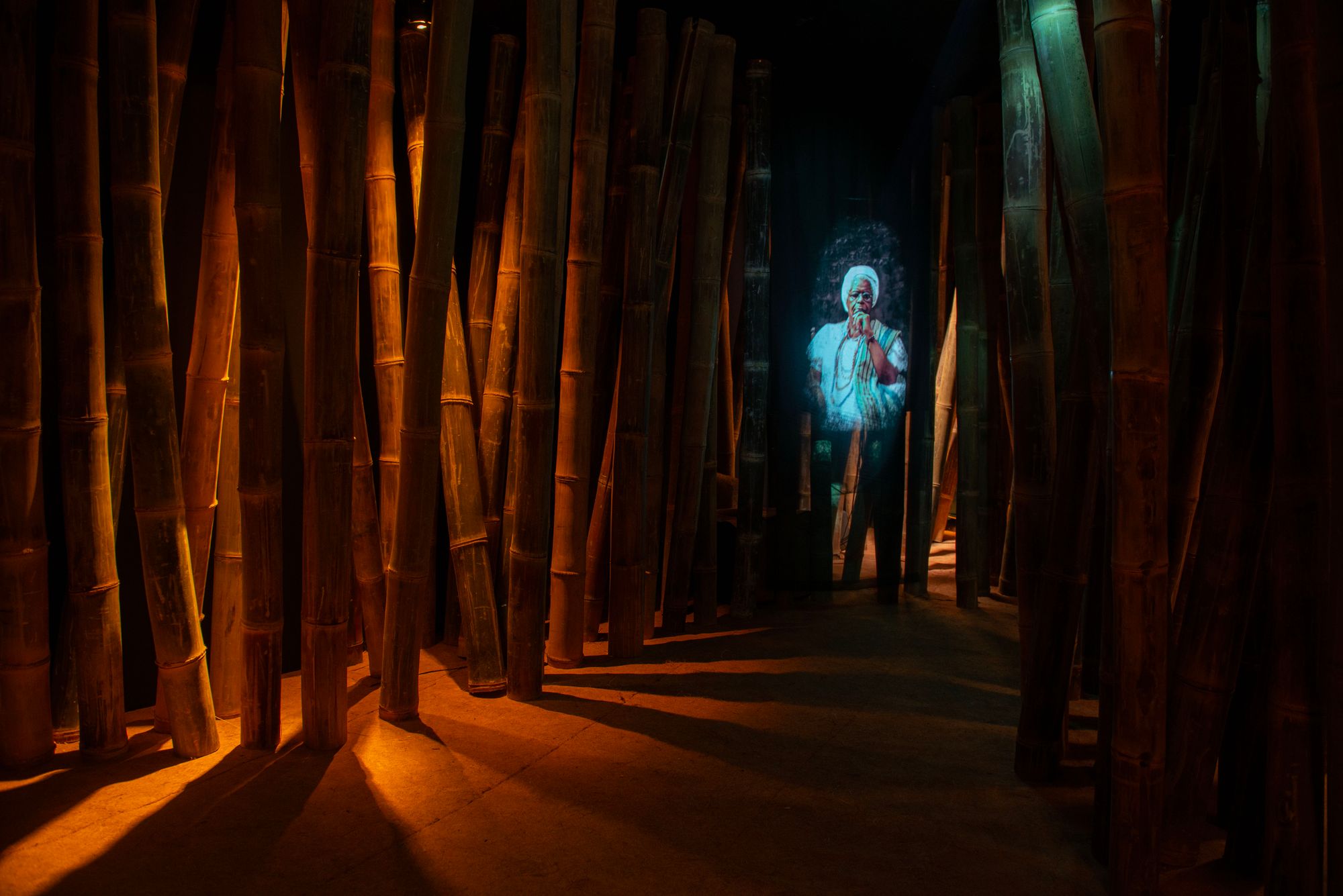
Exhibition views of the 35th Bienal de São Paulo – choreographies of the impossible, 2023.
Another sort of unbounded and nonlinear choreography, this one conversational, was orchestrated by the Moroccan artists Nadir Bouhmouch and Soumeya Ait Ahmed. A circular seating area of rugs, cushions, and zines (their Against Monoculture series) was arranged to screen their film A Seasonal Work Song (2020-2023). In an open dialogue after the film, Bouhmouch and Ahmed described their work as rooted in recuperating the commons of the assays—a “technology of assembly,” as they put it. Evolved by the Amazigh people, who are indigenous to the northern reaches of the African Continent, assays refers to both a physical space and a practice of gathering. Their film, which chronicles a season of work in an apple orchard through a sonic weft of songs, was itself made through the patient process of forming relationships with their subjects. A collective, pluralized authorship formed, assembled from a call and response of WhatsApp audio exchanges, stretching across ancestral and digital technologies.
Over a meditative forty minutes, hands danced across A Seasonal Work Song, reaching for apples and placing them in crates, as the camera paused on the faces of workers for the length of a song or a quick insightful word, moving amongst leaves and along the supply chain. A dynamic polyvocal communion, the film crystallized the richness of such south-to-south encounters, and of connections freed from the monopoly of Global North-Western-Euro-American cities, languages, and institutions—for example, the mindfuck that it’s often cheaper to fly between Europe and Africa than between African countries. (I for one will not be mourning that Air France has suspended its service in Niger.) In São Paulo, far from my own maternal Niger, I met a Tuareg silhouette, M.—one of many such meaningful encounters. At choreographies of the impossible, spontaneous conversations followed those that had been planned.
*
When it comes to unsettling narratives commingled with colonial power, anti-Blackness, heteronormativity, and state violence, no gesture is more striking than literally poking holes in the Brazilian flag. I was told by R., my traveling companion and beloved friend who not only catalyzed the trip but also warmly, generously enriched it with her insights, that the flag has in the past few years become a symbol of support for the country’s recently parted fascist president, Jair Bolsonaro. In Luiz de Abreu’s piece O Samba do Crioulo Doido (2004), the artist wears, struts around in, and plays with it. A choreographer and performer, de Abreu’s dance practice began in the 1960s, anchored in the rituals and practices of Umbandist terreiros, spaced for Afro-Brazilian religious practices. O Samba do Crioulo Doido was initially conceived in what de Abreu names “a moment of emergency and public utility,” as a response to racialized homophobic violence. The work studies and subverts anti-Black stereotypes and forms of essentialist, primitivizing diminishment—exaggerated large red lips, overly wide-eyed smiling and laughter—as it toys with traditions of Black performance and expressions, including samba and carnival.

Luiz de Abreu, Samba do crioulo doido, Exhibition views of the 35th Bienal de São Paulo – choreographies of the impossible, 2023.
A live performance of de Abreu’s piece took place during the biennial’s opening week; a large-scale video projection of an earlier recorded performance played in a dark alcove. The latter was accompanied by a smaller screen that played a behind-the-scenes documentary (O Samba do Crioulo Doido: Ruler and Compass, 2020). In the film, de Abreu has been losing his eyesight, and the younger dance artist Calixto Neto studies the elder’s body to prepare for the live performance. Relying on touch and sound, haptics and orality, his body is an archive for a longer history. De Abreu names their rehearsals as a process of invention, as they co-create a language of transmission which does not yet exist. At one point in the documentary, he makes a joke about it not being the open veins, but “the open legs” of Latin America that count, a darkly funny linguistic nod to Eduardo Galeano’s Open Veins of Latin America: Five Centuries of the Pillage of a Continent (1971). A Marxist diagnosis of the exploitative structures and economic dependency imposed on the Americas by European colonization, Galeano’s watershed book connected those histories to more recent depredations, from the nineteenth century on, by the imperial aims and capital of the United States.
Something about the psychosonic experience of O Samba do Crioulo Doido embedded itself in me. I was half-humming the tune to myself for weeks following, and this piece and artist felt particularly close to the heart of choreographies of the impossible. Gesture as inventory. Memory-keeping through the body. Movement as only another form of translation.
The sinuous, undulating choreography passed between de Abreu and Neto labored to resignify and create another vocabulary, attentive to the ways Black embodiment is marked as a site of infinite extraction and exploitation, and to the possibility of queer Black gestural erotic refashioning—a kinetic dissidence. Their new language spoke beautifully to the way Martins’ concern with memory, orality, physical knowledge, and liberatory performance shaped choreographies of the impossible. Martins relies on the crossroads as a conceptual key to address the vast web of encounters which have channeled Black Brazilian cultural forms, and oralitura as a fluid realm of expressive performance and language.
As I tried to see and feel the ruptures of choreographies of the impossible, the two nagging words insistently punctuating my thoughts were “finance” and “capital.” Biennials are both expensive to produce and containers for enacting the anxieties, antagonisms, and alliances of the elite’s global world order in symbolically and materially charged ways. Precisely because of the imaginative spins and unruly sequences of the São Paulo Biennial—its diligently emancipatory feel—there was an inevitable sourness to remembering that the bones stay the same. The curatorial framing certainly didn’t strike me as the sort of calculated verbal trompe-l’oeil that elite institutions often offer in times of tumult, too often laid atop open wounds of ongoing violence—this wasn’t that. But there is only so much that can be done within certain frameworks.
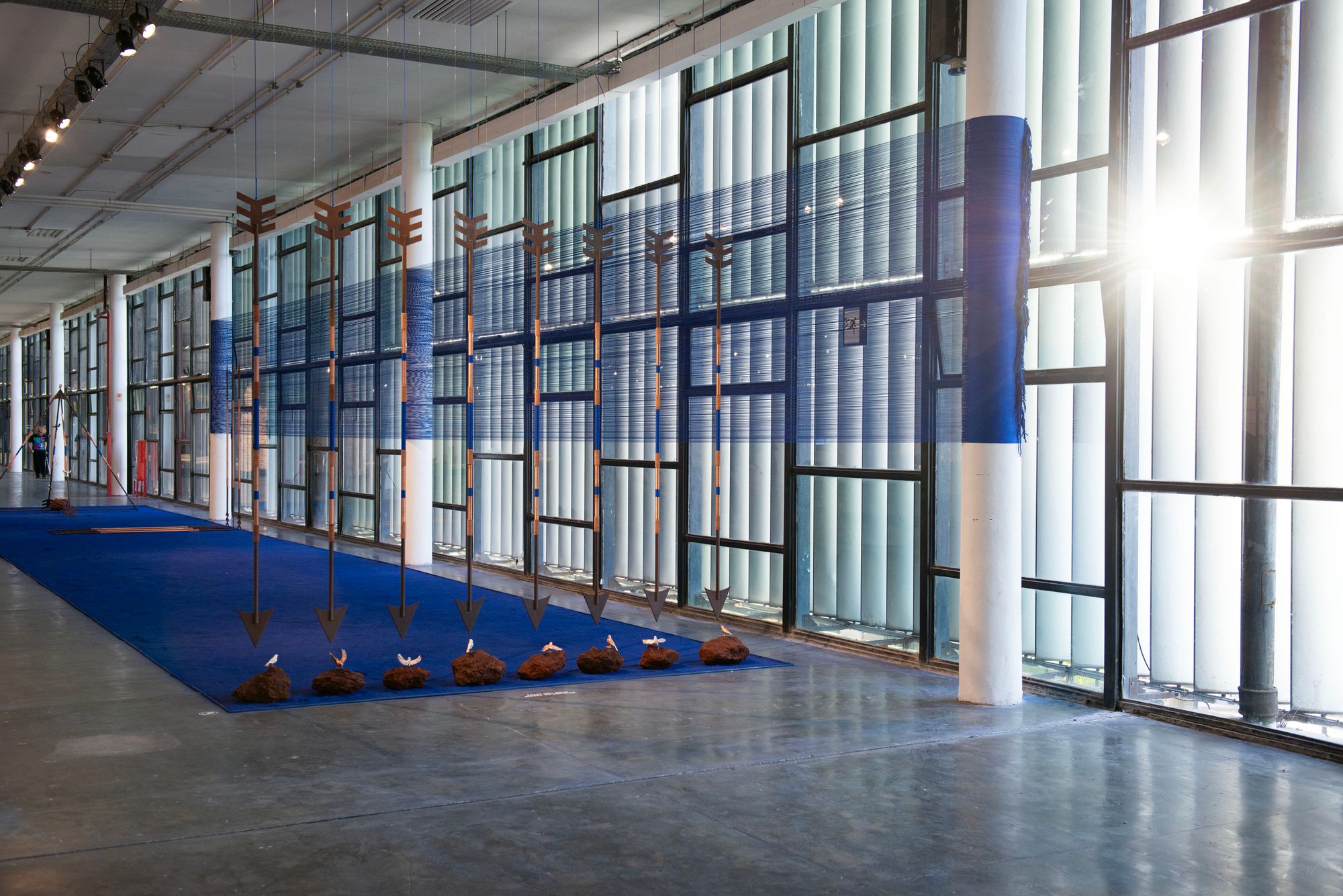
Exhibition views of the 35th Bienal de São Paulo – choreographies of the impossible, 2023.
© Levi Fanan / Fundação Bienal de São PauloIndeed, months later, we are witnessing something kindred, different but shared in terms of inflexible structures and art produced to breach them. It would be its own ugliness to suggest that the genocide that continues in Gaza is something new, or somehow delinked from the histories of brutality that choreographies of the impossible highlighted and, through their illumination, aimed to disrupt.
As my time in São Paulo came to a close, I was reminded of how, in their opening panel, the curators had insisted on their heterogeneity as an experiment in reimagining and questioning. They referred to procedural challenges while celebrating the richness of their collaboration. It was fascinating if opaque to hear them say that violence was not a mediator for their open-ended laboratory of radical decision-making, and that consensus was not the modus operandi. What then was that alchemy? We were left with a question that could only be answered by looking at how it was metabolized in the show itself.
Everything felt openly and intentionally fractured. This was perhaps why I kept getting lost, as I wondered at what worked, and what was worked over, or left intact. The artworks in the pavilion were not mapped by temporal proximities, geographic similarities, thematic cohesion, scalar equivalencies, or correlations of medium. choreographies of the impossible kept interrupting itself, haunting itself, making this very rigid building feel like it might be molten. Melting. These curated objects and offerings were not at rest. Laid out in beautifully dissonant archipelagoes, the space between them remained agitated and kinetic, producing an irreconcilable fragmentation and constant abruptness that left room for the things we need if we are to attempt total transformation—failure, absence, incompletion. Another reminder that I had initially worried over the wrong kind of legibility.

Exhibition views of the 35th Bienal de São Paulo – choreographies of the impossible, 2023.
© Levi Fanan / Fundação Bienal de São PauloThe work of many artists has remained with me, offering still more portals and escapes and secrets. Born from the inheritances of peoples who have already survived apocalypses, the vision for choreographies of the impossible was openly utopic, embodied, exploratory. It was an experiential experiment, playing with the limitations of a form. Its indictments of capital and coloniality could not be too directly applied to the financial apparatus and architectures of power that enabled the Biennial itself (all those little Bloomberg stickers everywhere). What was true of the architectural modification to Niemeyer’s design was true of the biennial itself: a container bending, not breaking.
By the last two days, I knew to expect the incline before turning onto Rua Tomás Carvalhal. But somehow I never learned to expect the cold of the apartment’s tap water, which never warmed. I was delighted each time I was able, in the shop where I stopped on the way home, to smell the guavas from one aisle away. A spiraled time of living ahead of or behind myself, depending, a tiny time lag somehow still beyond my grasp. ♦
Subscribe to Broadcast